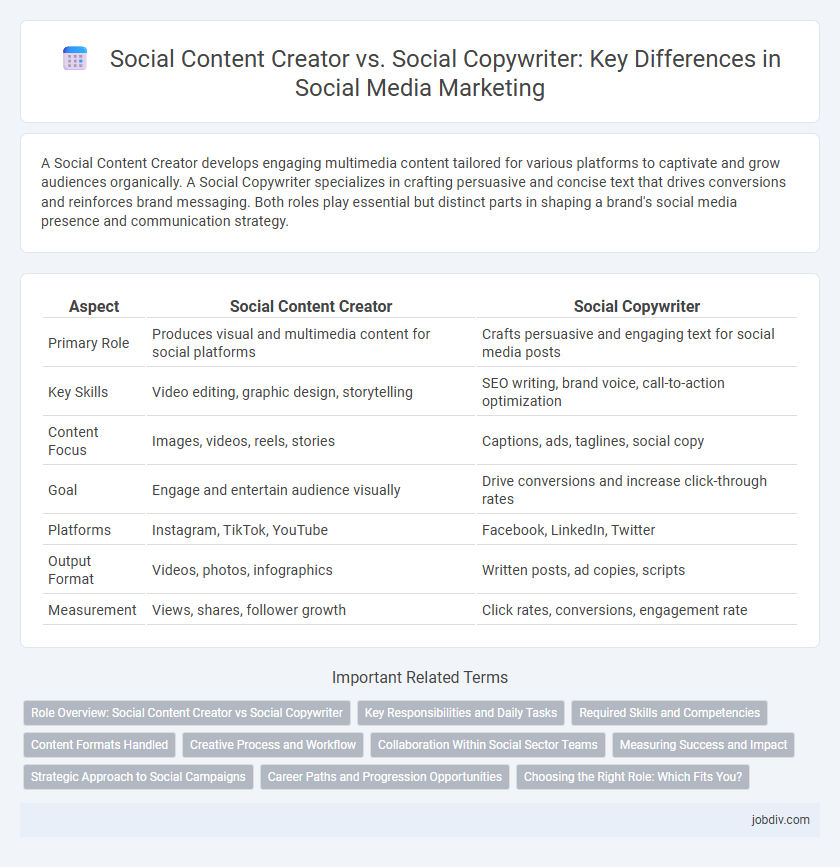A Social Content Creator develops engaging multimedia content tailored for various platforms to captivate and grow audiences organically. A Social Copywriter specializes in crafting persuasive and concise text that drives conversions and reinforces brand messaging. Both roles play essential but distinct parts in shaping a brand's social media presence and communication strategy.
Table of Comparison
| Aspect | Social Content Creator | Social Copywriter |
|---|---|---|
| Primary Role | Produces visual and multimedia content for social platforms | Crafts persuasive and engaging text for social media posts |
| Key Skills | Video editing, graphic design, storytelling | SEO writing, brand voice, call-to-action optimization |
| Content Focus | Images, videos, reels, stories | Captions, ads, taglines, social copy |
| Goal | Engage and entertain audience visually | Drive conversions and increase click-through rates |
| Platforms | Instagram, TikTok, YouTube | Facebook, LinkedIn, Twitter |
| Output Format | Videos, photos, infographics | Written posts, ad copies, scripts |
| Measurement | Views, shares, follower growth | Click rates, conversions, engagement rate |
Role Overview: Social Content Creator vs Social Copywriter
Social Content Creators develop visually engaging and diverse multimedia content tailored to various social platforms, focusing on brand storytelling and audience interaction. Social Copywriters craft compelling, concise written messages designed to drive engagement, conversions, and clear brand communication through precise wording and strategic calls-to-action. While both roles enhance social media presence, Content Creators emphasize visual and creative elements, whereas Copywriters specialize in persuasive, targeted text.
Key Responsibilities and Daily Tasks
Social Content Creators develop engaging multimedia materials across platforms, focusing on visual storytelling, video production, and interactive content to boost audience engagement and brand presence. Social Copywriters craft compelling, concise textual content, including headlines, posts, ads, and scripts, prioritizing tone, clarity, and persuasive messaging to drive conversions and align with brand voice. Both roles require collaboration with marketing teams, but Content Creators emphasize creative visuals while Copywriters specialize in strategic language.
Required Skills and Competencies
Social content creators excel in visual storytelling, creativity, and proficiency with multimedia tools to engage audiences across platforms, while social copywriters specialize in persuasive writing, SEO optimization, and crafting concise messages tailored to brand voice. Content creators require skills in video editing, graphic design, and trend analysis, whereas copywriters need mastery of keyword research, tone adaptation, and call-to-action techniques. Both roles demand strong understanding of social media algorithms, audience behavior, and content strategy to maximize reach and engagement.
Content Formats Handled
Social Content Creators specialize in a broad range of content formats, including videos, images, stories, and interactive posts designed for various social media platforms. Social Copywriters focus primarily on crafting compelling text-based content such as captions, ads, headlines, and scripts that drive engagement and conversions. While Content Creators manage multimedia assets, Copywriters optimize written messaging to enhance brand voice and communication effectiveness.
Creative Process and Workflow
Social Content Creators develop multimedia materials such as videos, images, and infographics, emphasizing visual storytelling and audience engagement through creative brainstorming and iterative design. Social Copywriters specialize in crafting concise, persuasive text tailored for social platforms, relying on keyword research, tone adaptation, and A/B testing to optimize message impact. Both roles integrate analytics and feedback loops to refine content strategies, but content creators prioritize visual elements while copywriters focus on language precision and brand voice consistency.
Collaboration Within Social Sector Teams
Social content creators and social copywriters play complementary roles within social sector teams by combining visual storytelling with impactful messaging to engage target audiences effectively. Collaboration involves aligning content strategy with organizational goals, ensuring that creative content resonates with community needs and advocacy objectives. Effective teamwork enhances campaign reach and drives social change through cohesive, purposeful communication across multiple platforms.
Measuring Success and Impact
Measuring success for social content creators centers on engagement metrics such as likes, shares, comments, and follower growth, reflecting audience interaction and community building. Social copywriters prioritize conversion rates, click-throughs, and campaign ROI to evaluate how effectively their persuasive messaging drives user actions. Both roles leverage analytics tools like Google Analytics, Facebook Insights, and native social media dashboards to quantify impact and optimize content strategies.
Strategic Approach to Social Campaigns
Social content creators develop visually engaging, platform-specific materials tailored to audience preferences, emphasizing creativity and brand storytelling to maximize engagement. Social copywriters specialize in crafting concise, persuasive text that aligns with campaign goals, optimizing messaging for conversions and audience resonance. Both roles require a strategic approach that integrates market research, audience insights, and analytics to design effective social campaigns that drive brand awareness and customer action.
Career Paths and Progression Opportunities
Social content creators develop multimedia posts and engage audiences across platforms, often advancing into roles like social media managers or digital strategists. Social copywriters specialize in crafting persuasive, brand-aligned messaging for ads, emails, and websites, with progression opportunities leading to senior copywriter, creative director, or brand strategist positions. Both career paths benefit from continuous skill development in SEO, analytics, and content marketing to boost long-term growth and marketability.
Choosing the Right Role: Which Fits You?
Social content creators specialize in producing engaging multimedia content tailored for platforms like Instagram, TikTok, and YouTube, using visual storytelling and trends to captivate audiences. Social copywriters focus on crafting persuasive, concise, and brand-aligned text for ads, social posts, and campaigns to drive conversions and maintain brand voice consistency. Assess your strengths in visual creativity versus strategic writing to choose the role that best fits your skills and career goals in social media marketing.
Social Content Creator vs Social Copywriter Infographic

 jobdiv.com
jobdiv.com